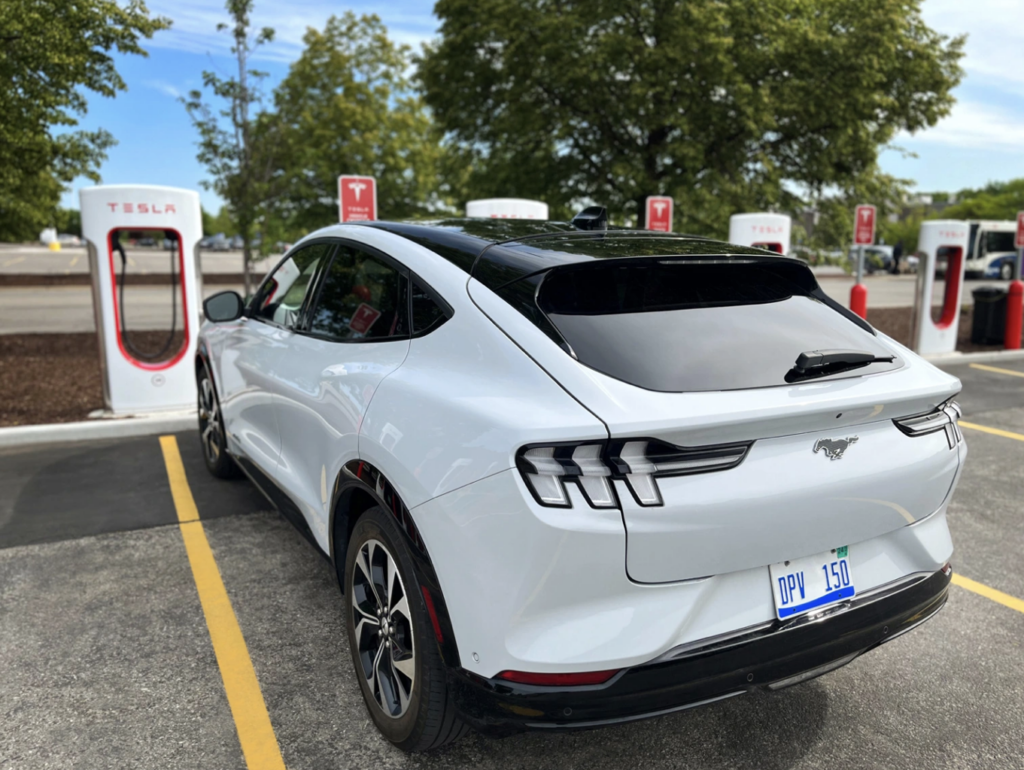Automakers move closer to EV owners’ dream of a single charging network
By Gabriela Aoun Angueira | July 4, 2023
 Beginning next year, Ford EVs like this Mustang Mach-E will be able to connect to Tesla Superchargers using an adapter. Image courtesy of Ford Motor Company.
Beginning next year, Ford EVs like this Mustang Mach-E will be able to connect to Tesla Superchargers using an adapter. Image courtesy of Ford Motor Company.
Editor’s note: This story was originally published by Grist. It appears here as part of the Climate Desk collaboration.
Ford CEO Jim Farley was driving his family back from vacation in Lake Tahoe last summer when he recognized something most EV owners know well: Public charging can be a headache.
On the 300-mile trip to Monterey, California, it wasn’t easy to find places to plug in his Ford Mustang Mach-E. His children had no problem, however, spotting the numerous Tesla Supercharger stations along the way.
“My kids kept looking at me, ‘Hey Dad, there’s another Supercharger, can we stop there? How about there?’” Farley recounted in a conversation on Twitter Spaces in May. “I’d say, ‘No, we have to go over here, behind this other building.’”
Farley said that was when he realized Tesla had done far better than any other charging network in creating an easy, dependable, and accessible customer experience. So easy, in fact, that he wanted Ford customers to be able to access it, too.
Farley was on Twitter to make an unprecedented announcement with Tesla CEO Elon Musk: Ford will join Tesla’s vast network of 12,000 Supercharger fast-charging stations. Early next year, it will offer an adapter that will allow Ford drivers to connect Tesla’s charging cables to their cars. Beginning in 2025, the company’s EVs will be manufactured with Tesla’s charging port.
“It was shocking,” said Loren McDonald, who runs the analytics firm EVAdoption, adding that Farley was sending a clear message. “He had absolutely no confidence that the charging networks could get their act together. Or why would you join with your competitor?”
The once unimaginable decision set off a cascade of echoing announcements. Two weeks later, General Motors CEO Mary Barra held her own Twitter Space with Musk to reveal that GM would join the network by offering adapters, to be followed by adopting its ports. Rivian and Volvo recently said the same.
The growing embrace of Tesla’s network could transform the public charging experience for EV drivers, who will gain access to Supercharger stations throughout North America. It is meant to catalyze EV adoption by providing a simpler, more expansive, and more reliable experience than those offered by notoriously unreliable third-party networks. And it suddenly increased the likelihood that the U.S. could one day see a single charging standard rather than the patchwork of systems that frustrate current EV drivers and could scare off potential ones.
While the announcements surprised many, in some ways they were inevitable. Tesla began building its proprietary global charging network over a decade ago, just as the company introduced its first sedan, the Model S.
“Tesla understood that in order for them to sell a lot of EVs, they had to take it upon themselves to build out the infrastructure,” said McDonald.
Perhaps presumptuously, Tesla named its system the North American Charging Standard, or NACS. In actuality, it is far from the standard. There are three EV fast-charging cable configurations in the United States. CHAdeMO connectors are used almost exclusively by the Nissan Leaf, while most other EVs use the Combined Charging System, or CCS. Each has a different shape, and they are not interchangeable.
No other automaker built a network like Tesla’s, leaving most EV drivers dependent upon third-party networks like EVgo, Chargepoint, and Electrify America for their public charging needs. Drivers often encounter broken chargers and long wait times, if they can find a fast charger at all.
In a 2022 survey by the consumer advocacy group Plug In America, one quarter of non-Tesla EV drivers said broken chargers or sparse locations were a “major difficulty” or “deal breaker” to using some of the biggest fast-charging networks. Only 2 percent to 3 percent of Tesla drivers said that of their network.
Customer frustration is catching up with legacy automakers and third-party charging networks, said Matt Teske, CEO of Chargeway, a mobile app designed to help users find and utilize charging stations.
“Everyone else was saying, ‘We build cars in a silo, you build chargers in a silo, but hopefully we make those things connect somehow,’” said Teske. That is, until the automakers saw that the two weren’t connecting. “They finally realized that the business model used by many third-party networks doesn’t truly serve the driver, and that impacted the ownership experience.”
The decision by two of the Big Three automakers to adopt Tesla’s standard will essentially double the number of places where customers can fill up. It will also simplify the experience. Whereas a typical Electrify America or Chargepoint station may have four to six chargers, Supercharger stations can have as many as 50 to 100, reducing or eliminating wait times. Tesla’s charging cable and connector are smaller and lighter than CCS and CHAdeMO, making them easier to handle, and its chargers don’t have screens, which can break or be difficult to read. Payments are made exclusively through a mobile app.
Teske said this kind of efficiency is key to getting drivers to abandon internal combustion. “What truly will accelerate electric vehicle adoption is, how do we get average consumers to look at using electricity as their fuel of choice when buying a car and say, ‘That’s easy,’” he said.
Of course, the Tesla charging network can’t bear the burden of charging all 1.8 million electric vehicles on U.S. roads today, much less the 28.3 million expected by 2030. By one estimate, the country will need 172,000 public fast chargers by then. It currently has about 9,000. As third-party networks scale up, the moves by Ford, GM, and Rivian put pressure on them to do better.
“It’s forcing everybody else to get their act together,” said McDonald, “because if they don’t, they’re out of business at some point.”
EVgo and Chargepoint, among others, have announced they will add NACS connectors to their stations. That, of course, does not address issues with spotty reliability or cumbersome user experiences.
Nor does it solve the problem of customer confusion over which connector is compatible with their car and which charging stalls offer that connection—an impediment to ownership that the adoption of a single universal charging standard could solve.
Some in the industry publicly support this idea, including General Motors. “We have a real opportunity to drive this to be the unified standard for North America, which will enable even more mass adoption,” Barra said during her conversation with Musk.
Adopting a single standard would not happen overnight—there are hundreds of thousands of electric vehicles already on the road that don’t use Tesla’s plug, and the world’s two largest automakers, Volkswagen and Toyota, have not indicated they will embrace NACS.
The Biden administration, which has invested billions in accelerating EV adoption, has not publicly supported a single standard either. On Tuesday, the Joint Office of Energy and Transportation announced it will collaborate with the Society for Automotive Engineers to conduct an expedited review of NACS as a potential “public standard.” Such a designation would make it available to any manufacturer, much like a USB-C cord, which could further NACS adoption by more automakers.
That said, a $5 billion grant program run by the Joint Office to build 500,000 charging stations by 2030 still requires eligible projects to include at least four CCS connectors. While Texas and Washington recently added requirements that such projects also include NACS connectors, the Joint Office has not followed suit.
“I think we’re headed down a two standard-connector path for much of the rest of this decade,” said McDonald, who likened the landscape to other widespread technologies with dueling interfaces, like Apple versus Android and Windows versus Mac.
In the short term, it’s possible that charging could become even more confusing, as networks try to accommodate all three standards in their stations. Drivers may need to rely on adapters that they attach to connector cables to make them compatible with their car, adding a layer of hardware that can break or get lost.
“This is what happens when you have a Wild West approach to technology and everybody’s trying to prove they have the best mousetrap,” Teske said. “Unless there’s a really strong push for regulation to step in and change the conversation, we’re going to have a very messy landscape for drivers to contend with for years to come.”
It is already possible to catch a glimpse of what automaker-agnostic Supercharger stations will look like by visiting one of Tesla’s 11 Magic Dock Supercharger locations, which include CCS adapters so other cars can plug in.
At the Magic Dock in Placerville, California, last week, Dawn Sorrell pulled up to charge a Tesla Model Y that she’d rented for a trip from Virginia to visit her mother in Northern California. It was her first time driving a fully electric car. “It’s a completely different mindset, I’m just figuring it out as I go,” she said.
Sorrell supported the idea of outside automakers accessing the Tesla network. “Anything where you’re opening it up more is going to be better,” she said, “because it’s stressful, making sure you have a charge.”

Together, we make the world safer.
The Bulletin elevates expert voices above the noise. But as an independent nonprofit organization, our operations depend on the support of readers like you. Help us continue to deliver quality journalism that holds leaders accountable. Your support of our work at any level is important. In return, we promise our coverage will be understandable, influential, vigilant, solution-oriented, and fair-minded. Together we can make a difference.
Keywords: EV, automobiles, carbon emission, climate change, electric vehicles, renewables
Topics: Climate Change















